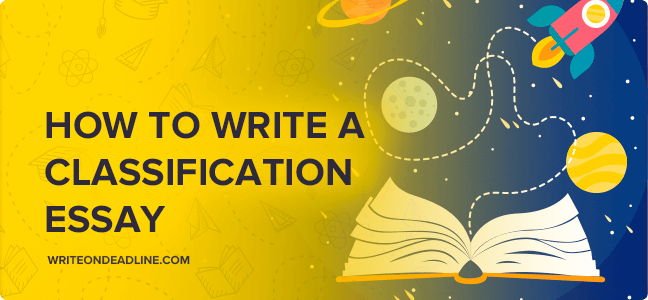Complete Guide on How to Write a Classification Essay

Table of Contents
Introduction to Classification Essays:
Imagine your closet. You’ve got shirts, pants, shoes, and a variety of accessories, all potentially scattered after a hectic week. When it’s time to tidy up, you start grouping items together—shirts with shirts pants with pants. In essence, you’re classifying your clothing to create order and make it easier to find what you need.
A classification essay functions similarly. It’s a form of academic writing where you categorize objects, ideas, or concepts into specific groups with a common denominator. This method serves to organize and discuss complex subjects in a clear, manageable way. The purpose? To offer insight, a fresh understanding, or an innovative perspective on the subject at hand. You’ll often find classification essays in academia, from high school all the way through college, in disciplines ranging from biology to social sciences to literature.
Choosing a Topic:
Selecting a topic for your classification essay is like choosing the perfect outfit for an occasion—it must be appropriate, and you should feel confident working with it. Begin with brainstorming sessions. Write down ideas that spark your interest or look at everyday objects and concepts from a new angle. Consider your audience and the scope of your assignment. Is your topic broad enough to find research but narrow enough to be covered within the confines of your essay?
Let’s say your interest is in sports. Instead of classifying sports in general, narrow it down to ‘Olympic sports’ or ‘team sports’. Remember, a good topic should not only pique your interest but also have sufficient dimensions for classification.
Research and Data Gathering:
A sturdy building needs a solid foundation, and so does a classification essay. Research is that foundation. Dive into books, credible websites, and scholarly articles to gather data about your chosen topic. Organize your findings using digital tools like spreadsheets or traditional note cards—whichever suits your style. Keep track of your sources for citations and ensure your data is relevant and up-to-date. This process will provide you with the raw materials to construct your categories.
Creating Categories:
With your research at hand, it’s time to start building—creating categories is like laying out the blueprints for your classification essay. Each category should have a clear basis for classification. For instance, if you’re classifying books, your categories could be based on genres such as fiction, non-fiction, and poetry.
When developing categories, aim for a clear and distinct separation between them. Overlapping categories can confuse readers and weaken your essay’s effectiveness. If some items don’t fit neatly, consider whether they are outliers or if your categories need adjustment. Perhaps you need an additional category, or maybe some items are too specific and need to be generalized. The goal is a balanced, well-structured essay where every item has its place, much like a well-organized closet.
In creating categories, remember to be fair and objective. Each category should be equally important and relevant to your topic. This ensures that your classification essay presents a well-rounded view of your subject matter, providing readers with a comprehensive understanding that is both enlightening and engaging.
As you continue on your journey of writing a classification essay, keep these foundational steps in mind. With a well-chosen topic, thorough research, and clearly defined categories, you’re well on your way to writing an essay that is as organized and functional as a well-kept wardrobe—and perhaps even more impressive.
Thesis Statement:
Crafting a thesis statement for a classification essay is like setting a guiding light for your readers. It should clearly state the topic the criterion of classification, and usually include the categories you plan to discuss. Think of it as a roadmap that indicates the direction of your essay and what the readers should expect. Here’s how to compose a potent thesis statement:
- Identify the subject of your classification.
- Determine the classification principle or criteria.
- List the categories you will discuss (usually, three to five is ideal for clarity and depth).
For example, if your essay classifies Olympic sports, your thesis statement might read: “Olympic sports can be categorized into endurance, precision, and team-based events, each demanding unique skills and offering different challenges for athletes.”
Outline:
An outline is the skeleton of your essay. It organizes your thoughts and ensures that you address all necessary points. A classification essay outline might look something like this:
I. Introduction A. Hook: Start with an interesting fact or a compelling question. B. Background information: Briefly touch upon the significance of the topic. C. Thesis statement: Clearly state the topic, classification criteria, and categories.
II. Body A. Category 1 1. Description and examples 2. Analysis of features and importance B. Category 2 1. Description and examples 2. Analysis of features and importance C. Category 3 1. Description and examples 2. Analysis of features and importance
III. Conclusion A. Summary of categories and significance B. Restatement of the thesis in light of the discussed evidence C. Final thoughts: Offer insights or suggest implications.
Essay Structure:
A classification essay’s structure should be straightforward and logical.
-
Introduction: This section sets the tone for your essay. Start with a hook to grab attention, provide some background information, and then present your thesis statement. The introduction should be direct and inform the reader about the classification you will discuss.
-
Body: The body of your essay is divided into sections, each dedicated to a specific category. Begin each section with a topic sentence that outlines the main idea of the category. Then, elaborate with examples, details, and analysis. Ensure that each category is discussed thoroughly and in equal depth to maintain balance.
-
Conclusion: The conclusion wraps up your essay by summarizing the main points and categories. It restates the thesis in a new light, considering the evidence and discussion presented. Conclude with final thoughts that highlight the importance of the classification and leave the reader with something to ponder.
Writing Tips:
Here are some tailored writing tips for a classification essay:
-
Maintain Clarity: Use clear and concise language to ensure that your readers understand the categories and the principle of classification. Avoid technical jargon unless your audience is familiar with it.
-
Avoid Complexity: Keep your categories straightforward and mutually exclusive; this avoids confusion. Don’t overcomplicate the classification with too many categories or overly fine distinctions.
-
Equal Development: Give each category the same level of attention and detail. Unequal development can make some categories seem less important than others, which can mislead the reader about their significance.
-
Consistent Principle: Apply your classification principle systematically. Each category should be classified according to the same principle to maintain coherence.
-
Logical Progression: Organize your categories in a way that makes sense. This could be simple to complex, least important to most important, or any other progression that adds to the clarity and persuasiveness of your essay.
-
Transitions: Use transition words and phrases to connect your categories and ideas smoothly. This helps in maintaining the flow of the essay.
Revision and Proofreading:
Revision and proofreading are the polishing cloth that makes your essay shine, ensuring that your classification is presented in the clearest, most engaging manner possible. Here’s how to approach this crucial stage:
-
Take a Break: After writing your draft, step away from it for a while. This distance gives you fresh eyes when you return for revision.
-
Read Aloud: By reading your essay out loud, you may catch errors or awkward phrases that you might miss when reading silently.
-
Check for Structure: Ensure that your introduction clearly sets up the classification principle and categories, each body paragraph focuses on a single category, and the conclusion effectively summarizes the essay.
-
Look for Clarity: Each category should be distinctly defined with clear examples. Check if the transitions between paragraphs and categories are smooth.
-
Consistency: Verify that you are consistently applying the classification principle throughout the essay.
-
Focus on Language and Tone: The language should be academic and appropriate for your audience. Ensure that your essay maintains a consistent tone throughout.
-
Proofread for Grammar and Spelling: Check for common errors such as misplaced commas, sentence fragments, subject-verb agreement issues, and spelling mistakes.
Revision Checklist:
- Is the thesis statement clear, and does it outline the categories?
- Do the introduction and conclusion effectively bookend the essay?
- Are the categories logically organized and well developed?
- Are examples relevant and supportive of the categories?
- Is the essay free of grammar, spelling, and punctuation errors?
- Have you cited all your sources properly?
Effective Revision Tips:
- Use grammar and spell-check tools as a first filter, but don’t rely on them exclusively.
- If possible, have a peer or mentor review your essay—they might spot issues you’ve missed.
- Address one type of correction at a time; for instance, focus on structure first, then clarity, and finally grammar and spelling.
Conclusion:
Writing a classification essay is an exercise in organization, analysis, and clarity. By choosing a relevant and intriguing topic, conducting thorough research, creating distinct categories, and composing a strong thesis statement, you set a solid foundation for your essay. The structure of your essay should guide the reader through your classification with ease, while your writing style should be clear and engaging, free from unnecessary complexity. Remember to allocate ample time for revision and proofreading, treating it as an essential part of the essay-writing process.
Now equipped with these tools and insights, you are ready to embark on the rewarding task of crafting your classification essay. Embrace the process, and let your newfound knowledge steer you toward a well-organized, insightful, and polished piece of writing.

